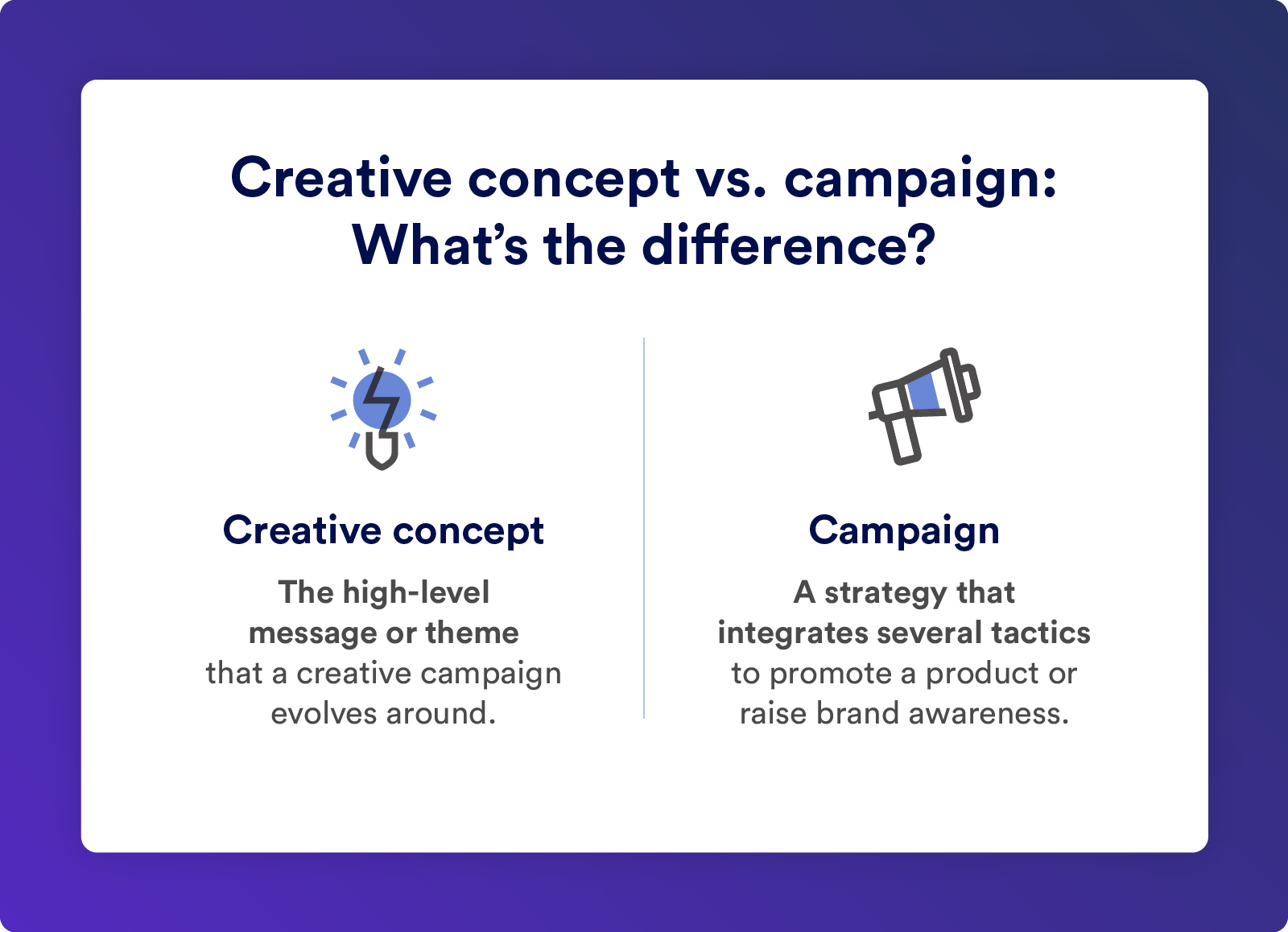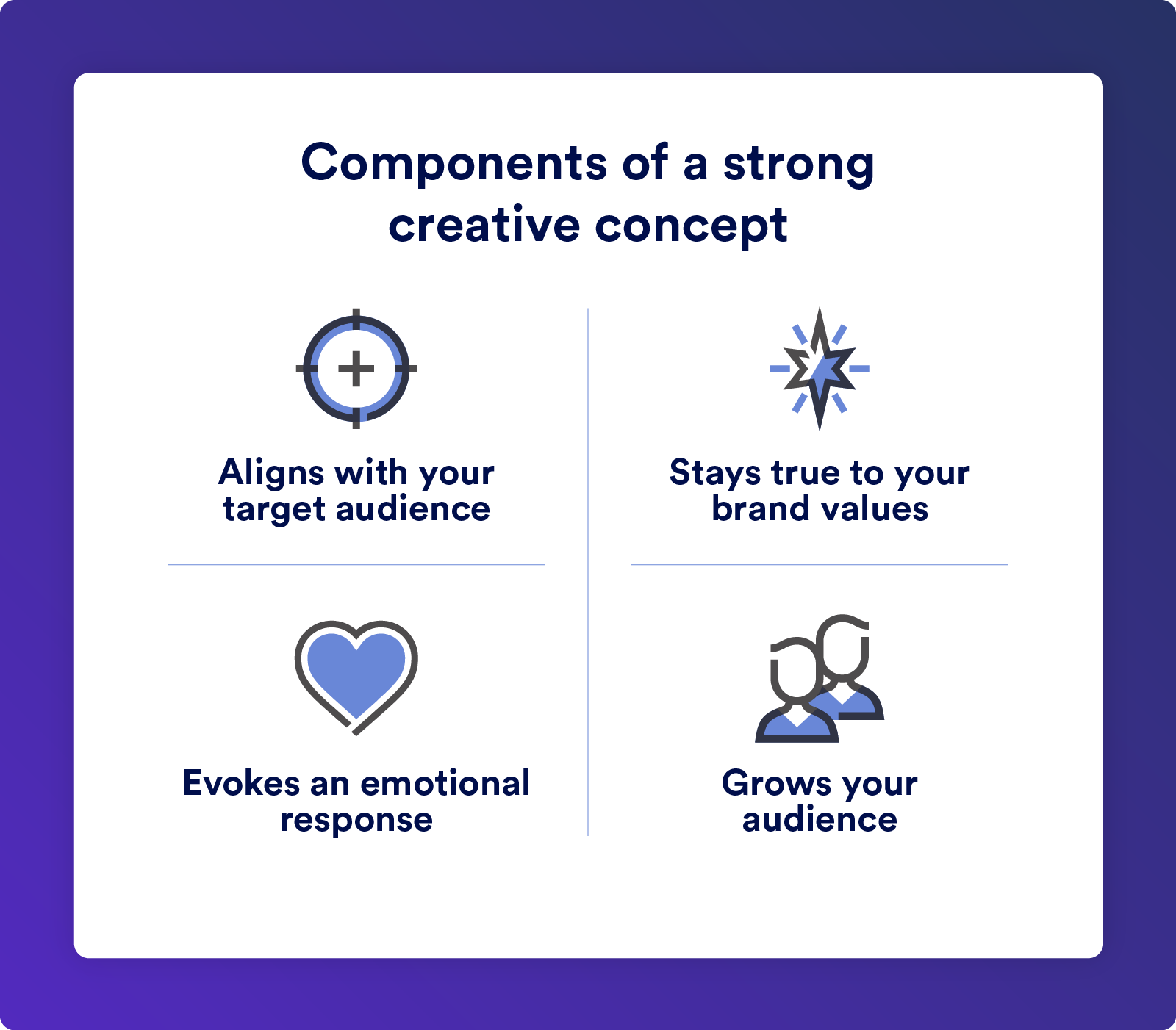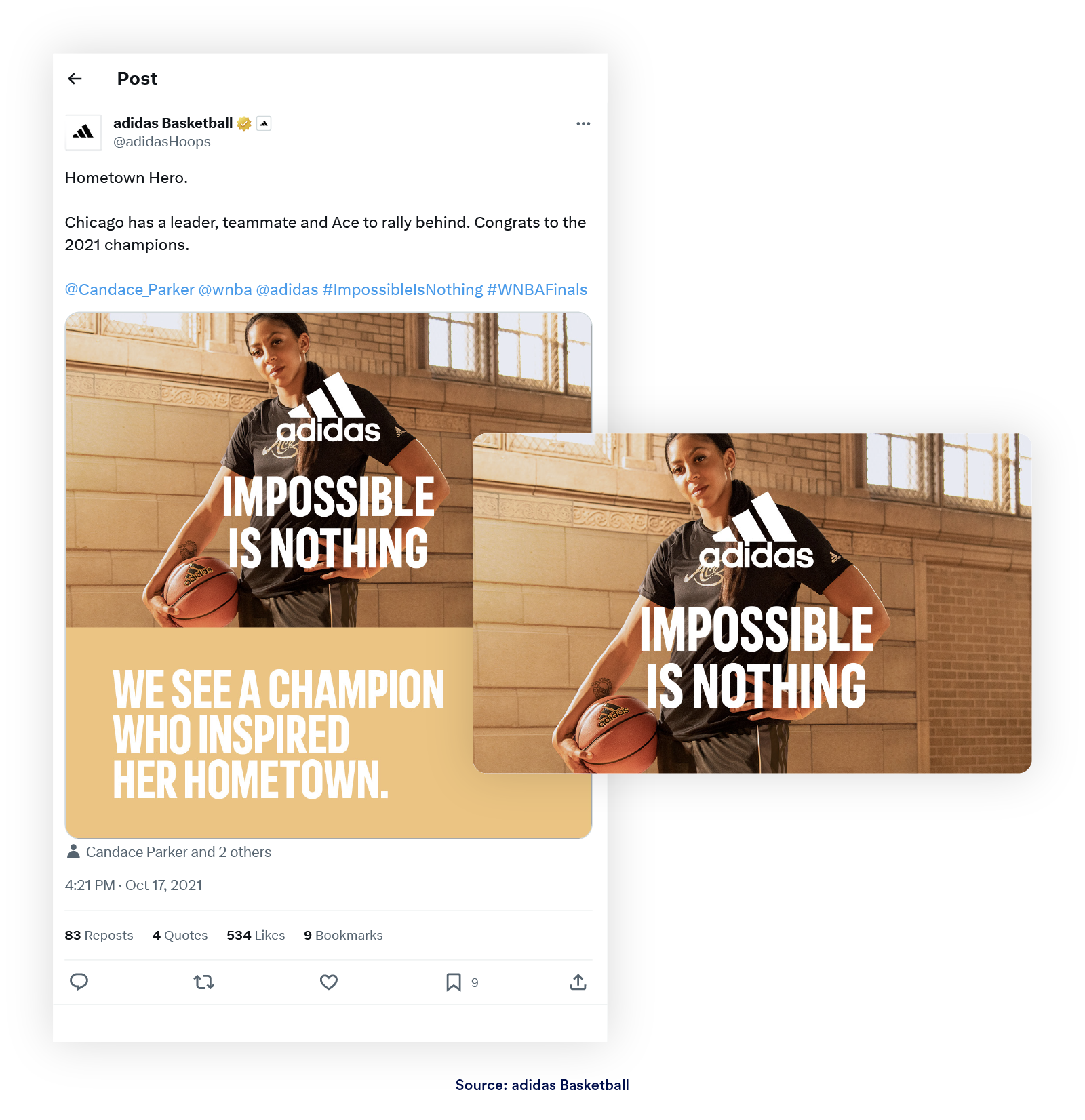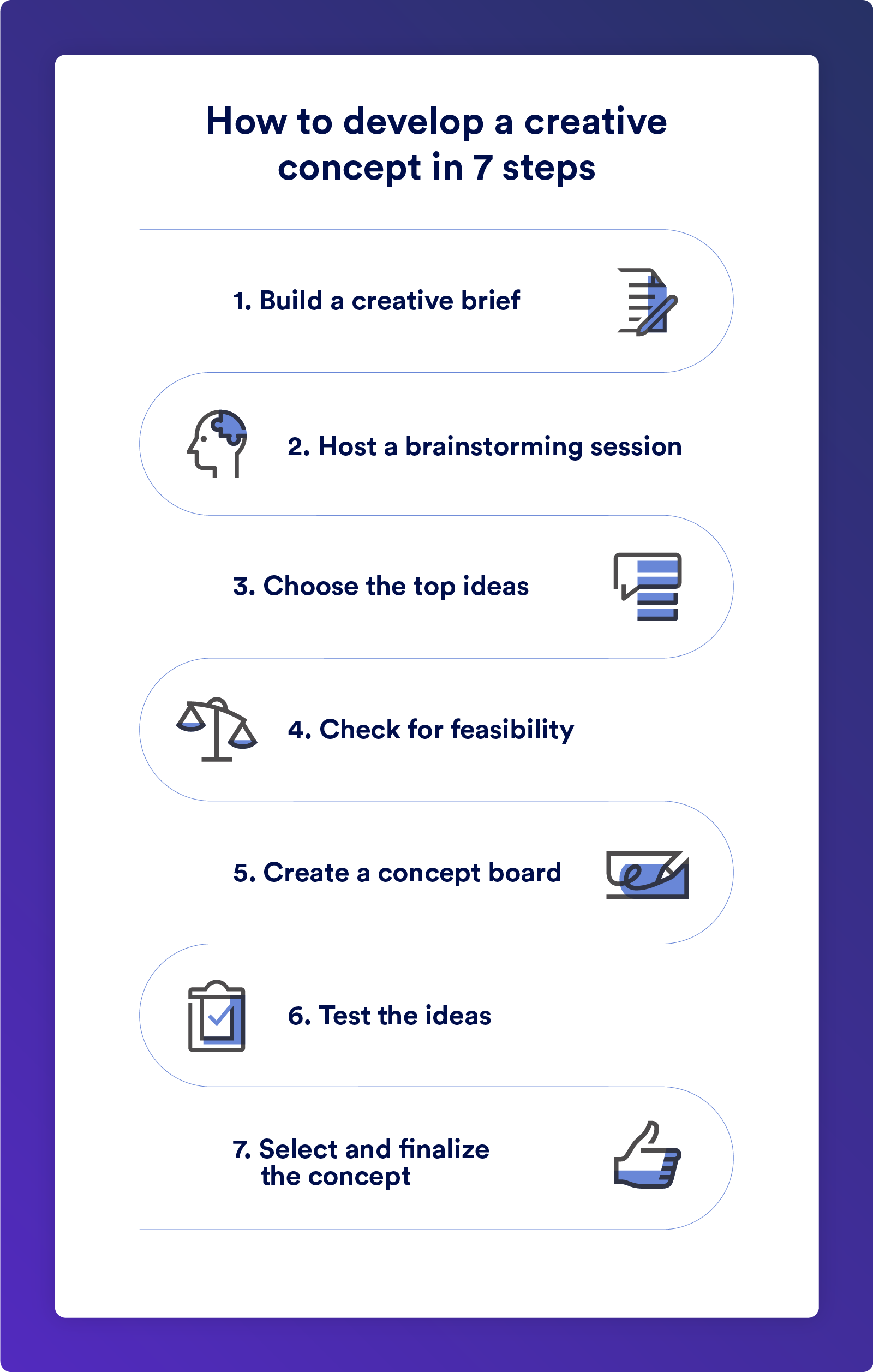Get branding tips and expert advice delivered straight to your inbox.
Behind every successful marketing campaign is a creative concept that helped inspire it and guide it to fruition. Creative concepts are more than just ideas — they help capture an audience’s attention and leave a lasting impression, making it hard for customers to forget your brand.
Ready to get your creativity flowing and develop a concept that will level up your marketing campaigns? Below, we’ll cover what a creative concept is, how it helps drive successful campaigns, and the steps for developing your own.
What Is a Creative Concept?
A creative concept is an overarching theme or idea that serves as the foundation for, and helps guide the creative direction of, a marketing campaign or creative project. It’s the big picture: the campaign’s core message. A successful creative concept is original, innovative, and, most importantly, memorable.

Creative Concept vs. Campaign
Creative concepts and campaigns work together to bring a creative vision to life. To fully grasp creative concepts, it’s important to also understand how they differ from campaigns.
Here are the main differences between a creative concept and a campaign:
- Messaging: A creative concept focuses on the high-level message or theme that a campaign will be centered around. A campaign is a strategy that incorporates several tactics, like social media marketing, advertising, TV, or brand events, to achieve a specific goal.
- Timing: Because a creative concept focuses on high-level messaging, it's not limited to a timeframe, and can be reused for other campaigns as long as it’s still relevant. Campaigns, on the other hand, are typically centered around promoting a new product, increasing brand awareness, or driving sales, and so they are time-bound and usually have defined start and end dates.
Why Is a Creative Concept Important?
A creative concept is essential when developing a campaign because it establishes an overarching message and theme that will be reflected throughout the campaign.
Creative concepts are important because they:
- Ensure creative teams are aligned on your campaign’s message.
- Differentiate your campaign and message from your competitors.
- Maintain cohesiveness across all campaign materials.
- Guarantee your campaign aligns with your target audience.
Components of a Winning Creative Concept

Want to know if your creative concept is campaign-worthy? Here are a few key components of a successful creative concept to keep in mind, as well as examples of some memorable creative concepts you may be familiar with.
Aligns With Your Target Audience
First, a winning creative concept resonates with your target audience. When developing your concept, it’s important to do thorough research and take your audience’s preferences, needs, and interests into account. This ensures you’re creating a concept that will establish a personal connection with your audience and increase your brand awareness — which will help drive campaign success.
Take Nike, for example. Its concept, “Just Do It,” which eventually became its slogan, resonates with its audience of athletes and those looking to live a healthy lifestyle — it motivates them to push their limits and reach their full potential.
Stays True to Your Brand Values
Any creative concept should communicate your brand’s core values. Brand values refer to the set of beliefs and standards your brand upholds and they’re critical when it comes to connecting with your customers. In fact, 77 percent of consumers say they buy from brands that share their values.
A creative concept that’s rooted in your brand values can not only foster a loyal connection with your audience but can also help you establish your brand identity, setting you apart from competitors.
Adidas’ “Impossible is Nothing” concept has been used in campaigns since 2004, pushing individuals to reach success no matter what obstacles they face. This concept has been the center of many campaigns over the years and has remained a significant reflection of Adidas’ brand identity. It aligns with the company’s core messaging and values of performance, passion, and integrity.

Evokes an Emotional Response
When trying to capture an audience’s attention, time is limited. But one of the best ways to reel someone in is to take them on an emotional journey. Ads that trigger an emotional response can persuade 70 percent of people to buy a product.
Whether you’re using humor or tapping into buyers’ frustrations to help sell your products, a successful creative concept can use both positive and negative emotional triggers to help convey its message.
Let’s look at Snickers. Its concept, “You’re not you when you’re hungry,” harps on the universal feeling of being frustrated and angry when you’re hungry — aka “hangry.” Its series of campaigns takes a comedic approach, showcasing several well-known stars engaging in outrageous behavior, then returning to their normal selves after eating a Snickers. This simple use of humor addresses a common frustration (hunger) and positions Snickers as the solution.
Widens Your Reach
A captivating concept can also expand your reach and grow your target audience. When your concept resonates with a broader audience, it can help break down demographic barriers, making your message more inclusive and relatable.
LEGO, whose primary demographic is young kids, expanded its target market by showcasing its products as a relaxing and therapeutic outlet for adults. Its concept, “Find Your Flow,” sheds light on something most adults can resonate with: stress. Its series of campaigns emphasizes this shared experience and illustrates how LEGO sets can be a way to escape that stress.
7 Essential Steps for Developing a Creative Concept
Developing a creative concept involves thorough research, collaboration, and creative thinking. Here are seven steps to create a clear and unique creative concept.

1. Build a Creative Brief
A creative brief is a document that outlines a campaign strategy and can serve as a roadmap for developing creative concepts. A creative brief typically includes the following:
- Project name
- Company description
- Project purpose
- Project objectives
- Target audience
- Preferred messaging
- Project deliverables
- Project deadlines
- Project budget
Creative briefs provide your team with an understanding of important campaign elements so they can create a concept that aligns with the campaign’s purpose and requirements.
For example, let’s say you’re a shoe company coming out with a new sneaker and want to launch a promotional campaign. Your creative brief will help your team understand your goals and objectives for the campaign, the preferred messaging, the budget, and the needed deliverables for different communication channels. With this background information, the team can come up with concept ideas that will help achieve the overall purpose of the campaign — to promote the new sneakers.
When building your creative brief, consider using a creative brief template to ensure you hit all the key components.
2. Host a Brainstorming Session
Now it’s time for the fun part. Select a group of people who will make up your brainstorming team, including a team leader, meeting facilitator, notetaker, and the individual team members who will be contributing ideas.
A successful brainstorming session is productive, engaging, and welcomes all creative ideas. Here are a few tips for your next session:
- Provide Information Ahead of Time: Provide the team with the creative brief and any additional information they need ahead of the brainstorming session. This ensures that they understand the campaign’s goals and objectives and can tailor their ideas accordingly.
- Start With an Icebreaker: Begin the meeting with an icebreaker to get everyone comfortable with one another. This is a fun and easy way to improve communication among the group before diving into the brainstorming session.
- Encourage a Creative Environment: To get your team’s creative juices flowing, try playing music or changing up the scenery by having the meeting outside. Try not to set any rules and allow ideas to flow freely so as not to impede the creative thinking process.
- Use a Brainstorming Technique: Depending on how you want to structure your brainstorming meeting, you might have participants brainstorm on their own before the session, or they might brainstorm as a group during the meeting using a brainstorming technique like mind mapping or brain writing.
- Welcome All Ideas: A successful brainstorming session means no ideas are off the table. Encourage team members to share anything that comes to mind, whether the concept is fully thought-out or not.
3. Choose the Top Ideas
Once everyone has had time to come up with ideas on their own and as a group, it’s time to choose the top contenders. If you have a large brainstorming team and several topics up for consideration, it may be wise to break up into small groups first, select the top two to three ideas, and then present them to the wider group.
From there, start narrowing down your concept ideas. Consider creating a scoring system to select the most promising ideas. Some common criteria may include creativity, relevance, uniqueness, feasibility, or audience alignment. Assign weights to the criteria based on their importance, and then assign scores to each concept. Select the top three ideas with the highest scores.
This will make it easier for your team to select concepts that align with your goals and objectives.
4. Check for Feasibility
Before choosing a concept, check its feasibility to ensure the concept can be properly executed. Refer back to your creative brief to make sure your concept aligns with it and ask yourself questions like:
- Does it attract our target audience?
- Does it stay within our budget?
- Do we have enough resources to execute it?
- What communication channels will we use for promotion?
- Are there any legal restrictions we need to consider?
- Does the topic offer a unique value proposition?
Consider getting feedback from additional team members and internal stakeholders to confirm the feasibility of the concepts and ensure there won’t be any roadblocks during execution.
5. Create a Concept Board
Next, bring your ideas to life with a concept board — a visual representation of your creative concept. A concept board includes a main visual or mockup, supporting images, a tagline, and any other important brand elements that help convey your idea.
Include any written direction as well, like the story behind your tagline and how it supports your brand’s core values, or how the concept will align with your target audience. Tap into storytelling to help your team understand the concept’s messaging, what makes it memorable, and how it can help guide the direction of your marketing campaign.
6. Test the Concepts
Now it’s time to put the three concepts you chose to the test and see if they resonate with your target audience. Testing your concepts helps uncover any unforeseen roadblocks or challenges you may encounter so you can make necessary tweaks to enhance your ideas.
Here are some ways you can test your concepts:
- Social Media: Create a teaser of your concept on the social media channels that are most popular among your target audience and monitor the engagement.
- Focus Groups: Organize focus groups with individuals from your target demographic to gather feedback and opinions on your concepts.
- Prototypes: Develop a prototype of your concept and test it internally with team members and stakeholders or externally with existing customers.
- A/B Testing: Conduct A/B testing on your website or social media channels with two versions and track which one gets the most engagement.
7. Select and Finalize the Concept
Finally, take all the feedback you gathered during testing, make adjustments if needed, and choose a final concept. From there, you can apply your concept to your campaign strategy. This is also a great time to refer back to your creative brief and finalize things like your campaign’s budget, resource allocation, and timeline.
Make the Creative Concept Process Easier with Brandfolder
Creative concepts are the foundation of any successful creative campaign. Creative project management tools, like Brandfolder by Smartsheet, can help foster collaboration and organize your creative assets so your team can seamlessly execute any campaign. Learn how Brandfolder can streamline your team’s creative workflows by scheduling a free demo.
